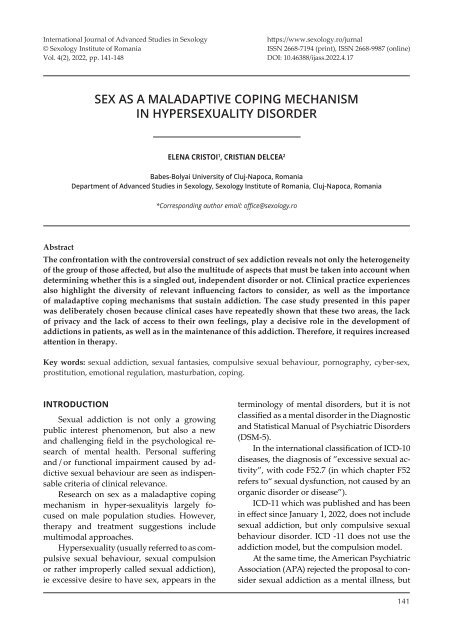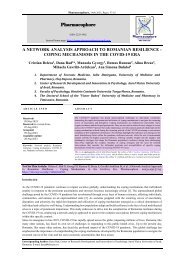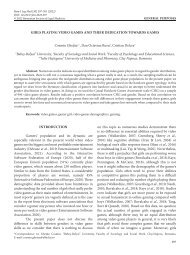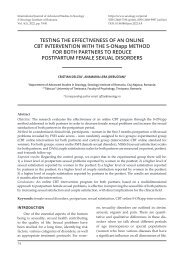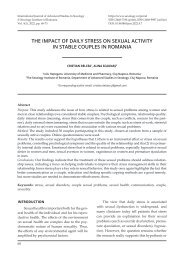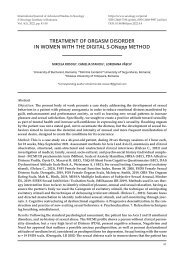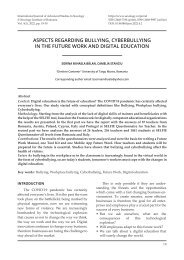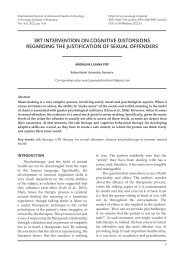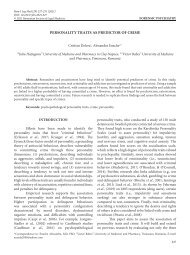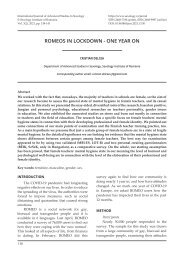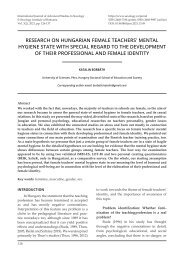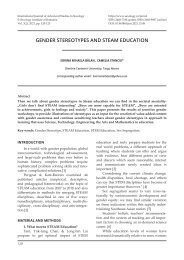Sex as a maladaptive coping mechanism in hypersexuality disorder
The confrontation with the controversial construct of sex addiction reveals not only the heterogeneity of the group of those affected, but also the multitude of aspects that must be taken into account when determining whether this is a singled out, independent disorder or not. Clinical practice experiences also highlight the diversity of relevant influencing factors to consider, as well as the importance of maladaptive coping mechanisms that sustain addiction. The case study presented in this paper was deliberately chosen because clinical cases have repeatedly shown that these two areas, the lack of privacy and the lack of access to their own feelings, play a decisive role in the development of addictions in patients, as well as in the maintenance of this addiction. Therefore, it requires increased attention in therapy.
The confrontation with the controversial construct of sex addiction reveals not only the heterogeneity of the group of those affected, but also the multitude of aspects that must be taken into account when determining whether this is a singled out, independent disorder or not. Clinical practice experiences also highlight the diversity of relevant influencing factors to consider, as well as the importance of maladaptive coping mechanisms that sustain addiction. The case study presented in this paper was deliberately chosen because clinical cases have repeatedly shown that these two areas, the lack of privacy and the lack of access to their own feelings, play a decisive role in the development of addictions in patients, as well as in the maintenance of this addiction. Therefore, it requires increased attention in therapy.
You also want an ePaper? Increase the reach of your titles
YUMPU automatically turns print PDFs into web optimized ePapers that Google loves.
International Journal of Advanced Studies <strong>in</strong> <strong>Sex</strong>ology<br />
© <strong>Sex</strong>ology Institute of Romania<br />
Vol. 4(2), 2022, pp. 141-148<br />
https://www.sexology.ro/jurnal<br />
ISSN 2668-7194 (pr<strong>in</strong>t), ISSN 2668-9987 (onl<strong>in</strong>e)<br />
DOI: 10.46388/ij<strong>as</strong>s.2022.4.17<br />
SEX AS A MALADAPTIVE COPING MECHANISM<br />
IN HYPERSEXUALITY DISORDER<br />
ELENA CRISTOI 1 , CRISTIAN DELCEA 2<br />
Babes-Bolyai University of Cluj-Napoca, Romania<br />
Department of Advanced Studies <strong>in</strong> <strong>Sex</strong>ology, <strong>Sex</strong>ology Institute of Romania, Cluj-Napoca, Romania<br />
*Correspond<strong>in</strong>g author email: office@sexology.ro<br />
Abstract<br />
The confrontation with the controversial construct of sex addiction reveals not only the heterogeneity<br />
of the group of those affected, but also the multitude of <strong>as</strong>pects that must be taken <strong>in</strong>to account when<br />
determ<strong>in</strong><strong>in</strong>g whether this is a s<strong>in</strong>gled out, <strong>in</strong>dependent <strong>disorder</strong> or not. Cl<strong>in</strong>ical practice experiences<br />
also highlight the diversity of relevant <strong>in</strong>fluenc<strong>in</strong>g factors to consider, <strong>as</strong> well <strong>as</strong> the importance<br />
of <strong>maladaptive</strong> <strong>cop<strong>in</strong>g</strong> <strong>mechanism</strong>s that susta<strong>in</strong> addiction. The c<strong>as</strong>e study presented <strong>in</strong> this paper<br />
w<strong>as</strong> deliberately chosen because cl<strong>in</strong>ical c<strong>as</strong>es have repeatedly shown that these two are<strong>as</strong>, the lack<br />
of privacy and the lack of access to their own feel<strong>in</strong>gs, play a decisive role <strong>in</strong> the development of<br />
addictions <strong>in</strong> patients, <strong>as</strong> well <strong>as</strong> <strong>in</strong> the ma<strong>in</strong>tenance of this addiction. Therefore, it requires <strong>in</strong>cre<strong>as</strong>ed<br />
attention <strong>in</strong> therapy.<br />
Key words: sexual addiction, sexual fant<strong>as</strong>ies, compulsive sexual behaviour, pornography, cyber-sex,<br />
prostitution, emotional regulation, m<strong>as</strong>turbation, <strong>cop<strong>in</strong>g</strong>.<br />
INTRODUCTION<br />
<strong>Sex</strong>ual addiction is not only a grow<strong>in</strong>g<br />
public <strong>in</strong>terest phenomenon, but also a new<br />
and challeng<strong>in</strong>g field <strong>in</strong> the psychological research<br />
of mental health. Personal suffer<strong>in</strong>g<br />
and / or functional impairment caused by addictive<br />
sexual behaviour are seen <strong>as</strong> <strong>in</strong>dispensable<br />
criteria of cl<strong>in</strong>ical relevance.<br />
Research on sex <strong>as</strong> a <strong>maladaptive</strong> <strong>cop<strong>in</strong>g</strong><br />
<strong>mechanism</strong> <strong>in</strong> hyper-sexualityis largely focused<br />
on male population studies. However,<br />
therapy and treatment suggestions <strong>in</strong>clude<br />
multimodal approaches.<br />
Hypersexuality (usually referred to <strong>as</strong> compulsive<br />
sexual behaviour, sexual compulsion<br />
or rather improperly called sexual addiction),<br />
ie excessive desire to have sex, appears <strong>in</strong> the<br />
term<strong>in</strong>ology of mental <strong>disorder</strong>s, but it is not<br />
cl<strong>as</strong>sified <strong>as</strong> a mental <strong>disorder</strong> <strong>in</strong> the Diagnostic<br />
and Statistical Manual of Psychiatric Disorders<br />
(DSM-5).<br />
In the <strong>in</strong>ternational cl<strong>as</strong>sification of ICD-10<br />
dise<strong>as</strong>es, the diagnosis of “excessive sexual activity”,<br />
with code F52.7 (<strong>in</strong> which chapter F52<br />
refers to“ sexual dysfunction, not caused by an<br />
organic <strong>disorder</strong> or dise<strong>as</strong>e”).<br />
ICD-11 which w<strong>as</strong> published and h<strong>as</strong> been<br />
<strong>in</strong> effect s<strong>in</strong>ce January 1, 2022, does not <strong>in</strong>clude<br />
sexual addiction, but only compulsive sexual<br />
behaviour <strong>disorder</strong>. ICD -11 does not use the<br />
addiction model, but the compulsion model.<br />
At the same time, the American Psychiatric<br />
Association (APA) rejected the proposal to consider<br />
sexual addiction <strong>as</strong> a mental illness, but<br />
141
hyper-sexuality can be caused by some medical<br />
conditions or drug treatments. In most c<strong>as</strong>es,<br />
the causes of sexual compulsion cannot be<br />
identified. Relatively recent research also highlights<br />
the existence of comorbidities <strong>in</strong> terms<br />
of sex addiction, especially mood <strong>disorder</strong>s,<br />
depression, hypo-mania - bipolar <strong>disorder</strong>,<br />
anxiety and substance abuse, ADHD, eat<strong>in</strong>g<br />
<strong>disorder</strong>s, gambl<strong>in</strong>g addiction and paraphiliac<br />
<strong>disorder</strong>s (Kafka, 2007; Kafka & Hennen, 2002).<br />
The concept of <strong>cop<strong>in</strong>g</strong> refers to the behavioural<br />
and cognitive efforts made by an <strong>in</strong>dividual<br />
<strong>in</strong> order to manage <strong>in</strong>ternal or external<br />
requests (and conflicts between them) that are<br />
rated <strong>as</strong> too solicit<strong>in</strong>g or far too large compared<br />
to <strong>in</strong>dividual resources (Lazarus & Folkman,<br />
1984, 1987)<br />
There is a traditional cl<strong>as</strong>sification, accord<strong>in</strong>g<br />
to Lazarus, <strong>in</strong> terms of problem-centered<br />
<strong>cop<strong>in</strong>g</strong> and emotion-centered <strong>cop<strong>in</strong>g</strong>. The first<br />
option is focused on solv<strong>in</strong>g, or, if not possible,<br />
m<strong>in</strong>imis<strong>in</strong>g the stressful situation and <strong>in</strong>cludes<br />
strategies for accept<strong>in</strong>g the confrontation with<br />
the stressor (Angelescu R., & Delcea C., 2020).<br />
Problem-centered <strong>cop<strong>in</strong>g</strong> h<strong>as</strong> strategies<br />
such <strong>as</strong>: present<strong>in</strong>g the problem, gather<strong>in</strong>g <strong>in</strong>formation,<br />
f<strong>in</strong>d<strong>in</strong>g alternative solutions, evaluat<strong>in</strong>g<br />
alternatives, resolv<strong>in</strong>g conflicts, but also<br />
efforts aimed at procur<strong>in</strong>g useful resources <strong>in</strong><br />
elim<strong>in</strong>at<strong>in</strong>g the exist<strong>in</strong>g problem: skills, tools,<br />
etc. (Atk<strong>in</strong>son et al., 2000).<br />
The second variant focuses on the person,<br />
on his / her ability to manage stress and <strong>in</strong>cludes<br />
forms of self-deception, through which<br />
a confrontation with the stressor is often postponed<br />
or even canceled (Baban, 1998).<br />
Emotion-focused <strong>cop<strong>in</strong>g</strong> does not change<br />
unfavourable situations, it only helps the person<br />
feel better (Monat & Lazarus, 1977). People<br />
use emotion-centered <strong>cop<strong>in</strong>g</strong> to prevent negative<br />
emotions from overwhelm<strong>in</strong>g them and to<br />
h<strong>in</strong>der them <strong>in</strong> their problem-solv<strong>in</strong>g actions.<br />
Or they may use this tactic when the problem<br />
is out of control (Atk<strong>in</strong>son et al., 2000). This<br />
type of <strong>cop<strong>in</strong>g</strong> tries to either change the way <strong>in</strong><br />
which the stressful relationship with the external<br />
environment is established through avoidance,<br />
either by alter<strong>in</strong>g the significance of what<br />
is happen<strong>in</strong>g around.<br />
The two types of <strong>cop<strong>in</strong>g</strong> support each other.<br />
Emotion-centered <strong>cop<strong>in</strong>g</strong> creates the space for<br />
better problem solv<strong>in</strong>g, and problem-centered<br />
<strong>cop<strong>in</strong>g</strong> reduces emotional distress through a<br />
more realistic <strong>as</strong>sessment (Băban, 1998).<br />
Folkman and Lazarus divided <strong>cop<strong>in</strong>g</strong><br />
strategies <strong>in</strong>to four groups, namely problem-focused,<br />
emotion-focused, support-seek<strong>in</strong>g<br />
and stress-<strong>cop<strong>in</strong>g</strong> (Folkman et al., 2004).<br />
Weiten identified four types of <strong>cop<strong>in</strong>g</strong> strategies:<br />
<strong>as</strong>sessment-oriented (cognitive-adaptive),<br />
problem-focused (adaptive behaviour), emotion-focused<br />
and occupation-focused <strong>cop<strong>in</strong>g</strong><br />
(Weiten & Floyd, 2008). Bill<strong>in</strong>gs and Moos have<br />
added avoidance operations <strong>as</strong> some that focus<br />
on emotion (Bill<strong>in</strong>gs & Moos, 1981). In fact, <strong>in</strong><br />
reality, people can adopt more <strong>cop<strong>in</strong>g</strong> strategies<br />
simultaneously.<br />
Usually, people use a mixture of several<br />
<strong>cop<strong>in</strong>g</strong> strategies, which can change over time.<br />
All of these strategies may be helpful, but some<br />
argue that those who use problem-oriented<br />
<strong>cop<strong>in</strong>g</strong> strategies will adapt better <strong>in</strong> life.<br />
Problem-focused <strong>cop<strong>in</strong>g</strong> <strong>mechanism</strong>s can<br />
allow an <strong>in</strong>dividual more control over his or<br />
her problem, while emotion-focused <strong>cop<strong>in</strong>g</strong><br />
can sometimes lead to a reduction <strong>in</strong> perceived<br />
control (<strong>maladaptive</strong> <strong>cop<strong>in</strong>g</strong>).<br />
Lazarus noted the connection between his<br />
idea of “defensive re-evaluations” or cognitive<br />
<strong>cop<strong>in</strong>g</strong> and Freud’s concept of “self-defence”,<br />
control strategies that thus overlap with a person’s<br />
own defence <strong>mechanism</strong>s (Rob<strong>in</strong>son,<br />
2005).<br />
C<strong>as</strong>e Study<br />
First session:<br />
The patient H. L, 46 years old, with a stable<br />
job <strong>in</strong> the university field, <strong>in</strong> a lead<strong>in</strong>g position,<br />
is already <strong>in</strong> his second marriage, presents<br />
himself to the psychologist’s office with problems<br />
<strong>in</strong> the area of sexuality.<br />
He describes himself <strong>as</strong> a sex addict, an<br />
avid consumer of pornography and dat<strong>in</strong>g<br />
prostitutes. These vices have been go<strong>in</strong>g on for<br />
more than 25 years, which is why his first marriage<br />
failed.<br />
He h<strong>as</strong> presumed that he is suffer<strong>in</strong>g from<br />
hyper-sexuality, thus justify<strong>in</strong>g his compulsive<br />
142
sexual behaviour. Specifically, the patient looks<br />
for porn movies dur<strong>in</strong>g the week that he downloads,<br />
then m<strong>as</strong>turbates to them. At le<strong>as</strong>t once<br />
a week he met prostitutes or looked for some<br />
when pornography w<strong>as</strong> no longer satisfy<strong>in</strong>g.<br />
Mr. H. L claims that he h<strong>as</strong> tried to temper<br />
his sexual compulsions over time, but to no<br />
avail, not even for a short time. Over the years,<br />
he h<strong>as</strong> managed to gather an impressive collection<br />
of pornographic films, which he does not<br />
yet want to give up, but which he admits keep<br />
him stuck <strong>in</strong> this sex addiction.<br />
He also mentions that except for the moments<br />
when he engages <strong>in</strong> sexual acts or m<strong>as</strong>turbates,<br />
he lives <strong>in</strong> a permanent and cont<strong>in</strong>uous<br />
state of mental stress and anxiety, which<br />
he manages to satisfy<strong>in</strong>gly alleviate only<br />
through sexual behaviours, but unfortunately<br />
this state of calm and relaxation is temporary<br />
and the need to escape <strong>in</strong>to sexual fant<strong>as</strong>ies<br />
soon returns.<br />
Anamnesis<br />
Patient H. L grew up <strong>in</strong> a Catholic family,<br />
quite conservative, with 4 children, him be<strong>in</strong>g<br />
the youngest. His mother became pregnant<br />
with him at a fairly advanced age, the result<br />
of an unplanned pregnancy. Between him and<br />
his sibl<strong>in</strong>gs be<strong>in</strong>g an age difference of 17, 18, respectively<br />
20 years. The topic of sexuality w<strong>as</strong><br />
a taboo subject <strong>in</strong> the family. He says he w<strong>as</strong> an<br />
early developed child, both <strong>in</strong>tellectually and<br />
physically. He reports that he started m<strong>as</strong>turbat<strong>in</strong>g<br />
at a fairly early age, more precisely s<strong>in</strong>ce<br />
he turned 10 years old. He found that it calmed<br />
him down when he felt overly tense or lonely.<br />
Sometimes he m<strong>as</strong>turbated out of boredom or<br />
when he felt angry.<br />
As a child he says he w<strong>as</strong> shy and anxious,<br />
but with a very rich imag<strong>in</strong>ation. He remembers<br />
that most of his childhood he lived <strong>in</strong> an<br />
environment devoid of quarrels or material<br />
difficulties, but which he felt w<strong>as</strong> emotionally<br />
sterile. He missed his parents’ affection, especially<br />
his mother’s warmth.<br />
His family had a very good f<strong>in</strong>ancial situation<br />
and his parents were busy with the family<br />
bus<strong>in</strong>ess most of the time. Both the mother<br />
and the father tried to make up for the lack of<br />
time spent with him <strong>as</strong> a child, giv<strong>in</strong>g him the<br />
chance to frequent camps and trips both <strong>in</strong> the<br />
country and abroad.<br />
He studied at the best schools <strong>in</strong> Germany<br />
and Switzerland and proudly remembers that<br />
it w<strong>as</strong> awarded every year, his results always<br />
excellent. He confesses that he w<strong>as</strong> born with<br />
a special talent <strong>in</strong> the field of mathematics. At<br />
the age of 46, he manages to memorise with<br />
the same e<strong>as</strong>e, <strong>in</strong>formation and complex calculation<br />
formul<strong>as</strong> and to solve problems of advanced<br />
mathematics without great difficulties.<br />
He also says that <strong>as</strong> a child he w<strong>as</strong> always be<strong>in</strong>g<br />
<strong>in</strong> the care of his nannies or grandparents<br />
and <strong>as</strong> a teenager he did not have very close<br />
friends. His sexual development w<strong>as</strong> smooth,<br />
with his first sexual experience at the age of 19<br />
with a prostitute. He remembers exactly the<br />
details of that first <strong>in</strong>timate moment and says<br />
he didn’t necessarily feel ple<strong>as</strong>ure. Describes<br />
the experience <strong>as</strong> more tir<strong>in</strong>g than enjoyable.<br />
He did not discuss sex with anyone <strong>as</strong> a<br />
teenager. Dur<strong>in</strong>g puberty he developed some<br />
curiosity for the opposite sex, but he w<strong>as</strong> not<br />
very curious to f<strong>in</strong>d out what it w<strong>as</strong> actually<br />
like to have sex with a regular girl. He knew<br />
that his brothers also frequented prostitutes,<br />
but he never talked to them about it. He took<br />
<strong>in</strong>formation and what he w<strong>as</strong> particularly <strong>in</strong>terested<br />
<strong>in</strong> <strong>in</strong> the direction of sexuality from<br />
books or magaz<strong>in</strong>es. As his <strong>in</strong>terest <strong>in</strong> sexuality<br />
grew later on, he satisfied his needs from porn<br />
movies or with women paid for sex.<br />
He had his first serious emotional relationship<br />
<strong>as</strong> a student and it l<strong>as</strong>ted about two years.<br />
He remembers that his girlfriend at the time<br />
w<strong>as</strong> the daughter of a well-known urologist<br />
<strong>in</strong> the town where they both studied and she<br />
took notice and made him aware of his sexuality<br />
and compulsive sexual behaviour, but that<br />
didn’t prompt him to take any action then nor<br />
after their relationship h<strong>as</strong> ended.<br />
He married his first wife at the age of 28,<br />
but their marriage ended two years later, because<br />
she found out about his habit of attend<strong>in</strong>g<br />
brothels and frequent<strong>in</strong>g prostitutes. He<br />
h<strong>as</strong> been married to his second wife for 10<br />
years, they have two daughters, the youngest<br />
of whom is 7 years old and is under permanent<br />
143
medical treatment and supervision. She suffers<br />
from a rare heart congenital defect and the risk<br />
of death is very high, <strong>in</strong> the event of a shock or<br />
a strong emotional moment.<br />
This causes the patient a constant state of<br />
fear, helplessness, stress and worry. He states<br />
that the sex addiction w<strong>as</strong> accentuated with<br />
the f<strong>in</strong>d<strong>in</strong>g of his daughter’s diagnosis but<br />
also with the tak<strong>in</strong>g over of the lead<strong>in</strong>g position<br />
with<strong>in</strong> the research department and <strong>in</strong>novation<br />
where he works professionally. Both<br />
changes took place at about the same time and<br />
from that moment he feels that he w<strong>as</strong> pushed<br />
<strong>in</strong>to is lead<strong>in</strong>g two completely parallel lives.<br />
His current wife h<strong>as</strong> known about his sex<br />
addiction for about a year and a half. The two<br />
of them, <strong>as</strong> spouses, have distanced each other,<br />
communicat<strong>in</strong>g only what is strictly necessary<br />
for the care of their girls. Their emotional relationship<br />
h<strong>as</strong> cooled a lot, but the patient claims<br />
that he loves his wife and would not want to<br />
divorce. He does not describe himself <strong>as</strong> a very<br />
emotional person. He reports that he h<strong>as</strong> great<br />
difficulty express<strong>in</strong>g his emotions <strong>in</strong> words<br />
when he feels them.<br />
The patient mentions that over the years<br />
he underwent several medical exam<strong>in</strong>ations,<br />
which all concluded that he is cl<strong>in</strong>ically healthy.<br />
The hyper-sexuality that affects his life did not<br />
have an organic causation, <strong>as</strong> it emerges from<br />
the medical evaluations made over time.<br />
The job he h<strong>as</strong> allows him to travel a lot,<br />
especially abroad, which h<strong>as</strong> facilitated the<br />
possibility for develop<strong>in</strong>g parallel relationships<br />
with several women, strictly for sexual<br />
purposes. In the l<strong>as</strong>t half year, he h<strong>as</strong> begun to<br />
neglect his family a lot, confess<strong>in</strong>g that he feels<br />
“like a guest <strong>in</strong> his own house”, permanently<br />
exhausted and with feel<strong>in</strong>gs of shame towards<br />
his wife and self, but also with feel<strong>in</strong>gs of deep<br />
guilt towards his children. The <strong>in</strong>ability to control<br />
his sexual impulses, says the patient, h<strong>as</strong><br />
negatively affected most are<strong>as</strong> of his life, especially<br />
<strong>in</strong> the l<strong>as</strong>t 12 months.<br />
His efficiency at work h<strong>as</strong> also dim<strong>in</strong>ished<br />
<strong>as</strong> well <strong>as</strong> his motivation for professional duties,<br />
which until recently offered him a fairly<br />
high satisfaction due to his performance <strong>in</strong> several<br />
<strong>in</strong>novative projects, all of which have seen<br />
a major decl<strong>in</strong>e. The patient spends most of his<br />
time with sexual fant<strong>as</strong>ies, m<strong>as</strong>turbation, pornography<br />
or cyber-sex, when he does not go to<br />
prostitutes.<br />
Methodology:<br />
The follow<strong>in</strong>g psychological tools were<br />
used to evaluate and diagnose the patient:<br />
Observation<br />
Unstructured cl<strong>in</strong>ical Interview<br />
Anamnesis<br />
The SAST (<strong>Sex</strong> Addiction Screen<strong>in</strong>g Test)<br />
Questionnaire where the patient H.L. obta<strong>in</strong>ed<br />
a 20 po<strong>in</strong>ts out of a possible 25 po<strong>in</strong>ts,<br />
which means that the diagnosis of “sex addiction”<br />
can be <strong>as</strong>signed accord<strong>in</strong>g to this<br />
screen<strong>in</strong>g method. The criteria accord<strong>in</strong>g to<br />
Kafka are also met.<br />
The HBI-19 questionnaire (Hypersexual<br />
Behavior Inventory-19) - <strong>in</strong> which the patient<br />
registered 84 po<strong>in</strong>ts out of 95 maximum.<br />
Axis I structured cl<strong>in</strong>ical <strong>in</strong>terview with<br />
SKID I (German version for SCID I) reveals<br />
a mild depressive episode (ICD-10: F32.0).<br />
In the diagnosis of personality,<br />
the IKP-Inventar Kl<strong>in</strong>ischer<br />
Persönlichkeitsakzentuierungen (German<br />
version for SCID II) w<strong>as</strong> used. Mr. H.L did<br />
not meet the criteria to be diagnosed with a<br />
personality <strong>disorder</strong>.<br />
What w<strong>as</strong> noticed were the scores recorded<br />
on the TAS-20 Questionnaire (Toronto<br />
Alexithymia Scale-20). The general score obta<strong>in</strong>ed<br />
w<strong>as</strong> 54, a score that does not highlight<br />
the characteristics of primary alexithymia,<br />
and only a suspicion <strong>in</strong> this direction. At the<br />
subscale “difficulties <strong>in</strong> identify<strong>in</strong>g feel<strong>in</strong>gs/<br />
emotions” -18 po<strong>in</strong>ts, at the “difficulty <strong>in</strong> describ<strong>in</strong>g<br />
feel<strong>in</strong>gs / emotions” - 26 po<strong>in</strong>ts, with<br />
“outward-fac<strong>in</strong>g th<strong>in</strong>k<strong>in</strong>g style” - 10 po<strong>in</strong>ts.<br />
In the TEQ Questionnaire (Toronto Emphaty<br />
Questionnaire) a score of 38 po<strong>in</strong>ts w<strong>as</strong> obta<strong>in</strong>ed<br />
out of a maximum of 64 po<strong>in</strong>ts. Scores<br />
below 45 <strong>in</strong>dicate below average empathy<br />
levels.<br />
Mr. H.L. also presents a dysfunctional<br />
stress process<strong>in</strong>g, result<strong>in</strong>g from the evaluation<br />
made with the WOCS- (Ways of<br />
Cop<strong>in</strong>g Scale). It turned out that the <strong>cop<strong>in</strong>g</strong><br />
144
strategies used by the patient, were those<br />
with a focus on emotion, DISTANCE or<br />
ESCAPE - AVOIDANCE.<br />
The therapeutic plan<br />
The treatment goals were set with Mr. H.L.<br />
but changed several times dur<strong>in</strong>g the 9 months<br />
of therapy. At the beg<strong>in</strong>n<strong>in</strong>g of the treatment,<br />
they were sketched <strong>as</strong> follows:<br />
‣ Not want<strong>in</strong>g to go to prostitutes anymore<br />
‣ Stop or at le<strong>as</strong>t reduce the volume of pornographic<br />
material downloaded from<br />
<strong>in</strong>ternet and the time spent watch<strong>in</strong>g /<br />
m<strong>as</strong>turbat<strong>in</strong>g<br />
‣ The goals desired by the patient and which<br />
were the b<strong>as</strong>is of the therapy were:<br />
‣ To save his marriage<br />
‣ Not to disappo<strong>in</strong>t his wife<br />
‣ To be able to control their sexual impulses<br />
and to have control over their own<br />
‣ behaviour <strong>in</strong> general (“I want to be able to<br />
trust myself aga<strong>in</strong>”)<br />
In the first weeks, the therapy focused especially<br />
on behavioural approaches and on<br />
identify<strong>in</strong>g the l<strong>in</strong>k between the trigger<strong>in</strong>g situations<br />
(especially stress, overwork and helplessness<br />
at work), <strong>in</strong> family life but also <strong>in</strong> the<br />
result<strong>in</strong>g sexual activities (go<strong>in</strong>g to prostitutes<br />
after work or watch<strong>in</strong>g porn on laptop dur<strong>in</strong>g<br />
work / home <strong>in</strong> the even<strong>in</strong>g).<br />
The proposed behavioural changes discussed<br />
with the patient <strong>in</strong> therapy were:<br />
Learn<strong>in</strong>g and practic<strong>in</strong>g regular relaxation<br />
techniques / exercises<br />
Journal<strong>in</strong>g<br />
Quality time spent with the girls, with the<br />
wife<br />
Purch<strong>as</strong><strong>in</strong>g a pet / Play<strong>in</strong>g a sport<br />
The suggestions were practically accepted<br />
and implemented by the patient <strong>in</strong> the follow<strong>in</strong>g<br />
weeks and even produced significant<br />
changes <strong>in</strong> his daily rout<strong>in</strong>e, especially <strong>in</strong> terms<br />
of approach<strong>in</strong>g stress. The new behaviours<br />
have significantly reduced the need to watch<br />
porn movies and m<strong>as</strong>turbate, but he h<strong>as</strong> not<br />
completely given up on them.<br />
Another important step for the patient<br />
w<strong>as</strong> to significantly reduce the download and<br />
view<strong>in</strong>g of pornographic material after about<br />
three months of therapy, through treat<strong>in</strong>g the<br />
connections between stress and high emotional<br />
load and the compulsion to m<strong>as</strong>turbate and go<br />
to prostitutes.<br />
There were also moments of discouragement,<br />
because the patient had not been able to<br />
completely give up dat<strong>in</strong>g with prostitutes after<br />
about 4 months of therapy. The emph<strong>as</strong>is <strong>in</strong><br />
the next stage of the treatment plan w<strong>as</strong> to f<strong>in</strong>d<br />
out the factors that contribute negatively to the<br />
fact that he cannot give up these visits.<br />
This changed his treatment goals for the<br />
first time. Above all, Mr. H.L. wanted to understand<br />
why he needed these meet<strong>in</strong>gs with<br />
prostitutes.<br />
Dur<strong>in</strong>g the therapy it w<strong>as</strong> discovered that<br />
beh<strong>in</strong>d his actions were various needs that had<br />
not been met until then:<br />
Deep need for privacy<br />
The desire to be loved “I feel like a visitor at<br />
home”<br />
A great need for recognition (especially at<br />
work) and the fear of disappo<strong>in</strong>t<strong>in</strong>g the other<br />
colleagues, respectively subord<strong>in</strong>ates.<br />
Mr. H.L remembers that <strong>as</strong> a child, he used<br />
to m<strong>as</strong>turbate when he felt alone. And later<br />
<strong>in</strong> adolescence, he practiced this habit plus<br />
dat<strong>in</strong>g prostitutes, because he often felt misunderstood,<br />
confused and strange, even <strong>in</strong> a<br />
relationship.<br />
The patient realised that through these<br />
regular visits he w<strong>as</strong> try<strong>in</strong>g to satisfy his unrecognised<br />
long<strong>in</strong>g for <strong>in</strong>timacy, the need for<br />
love, resort<strong>in</strong>g to sexual <strong>in</strong>tercourse with women<br />
paid exclusively for sex, emotional needs<br />
that he could not satisfy neither <strong>in</strong> the relationships<br />
he had before the marriage, nor <strong>in</strong> the<br />
first marriage, nor <strong>in</strong> the present marriage. He<br />
always felt like he w<strong>as</strong> look<strong>in</strong>g for someth<strong>in</strong>g,<br />
but he couldn’t describe what he w<strong>as</strong> miss<strong>in</strong>g.<br />
Mr. H.L sees the re<strong>as</strong>on for this <strong>in</strong> his desire<br />
to always seem superior and <strong>in</strong>dependent,<br />
to “allow himself no weakness,” to be always<br />
<strong>in</strong> control. He also says that <strong>as</strong> a child, he rarely<br />
saw moments of affection between his parents.<br />
They were very polite to each other, but without<br />
be<strong>in</strong>g very emotionally expressive.<br />
However, dur<strong>in</strong>g the therapy sessions,<br />
the patient showed a great desire for<br />
145
self-knowledge, especially <strong>in</strong> terms of privacy<br />
and emotions.<br />
His habit of always be<strong>in</strong>g <strong>in</strong> control and<br />
very good at everyth<strong>in</strong>g he does is <strong>in</strong> stark contr<strong>as</strong>t<br />
to his real and <strong>in</strong>ner desire to be accepted<br />
<strong>as</strong> he is, without hav<strong>in</strong>g to “accomplish” anyth<strong>in</strong>g.<br />
The patient realised that he w<strong>as</strong> hid<strong>in</strong>g<br />
his own needs, especially <strong>in</strong> order to be able<br />
to fulfil the model he had imposed on himself<br />
(and which he had unconsciously taken from<br />
his parents). That is, to avoid feel<strong>in</strong>gs and express<strong>in</strong>g<br />
his emotions, especially the negative<br />
ones, to keep away anyth<strong>in</strong>g that could cause<br />
him psycho-emotional discomfort.<br />
For example, long before he started therapy<br />
and a long time later, he stated that he felt at<br />
home <strong>as</strong> a visitor and only <strong>as</strong> the ma<strong>in</strong> supporter<br />
of the family, but not <strong>as</strong> part of the family.<br />
This new approach, <strong>in</strong>itially focused on his<br />
irrational and <strong>maladaptive</strong> cognitions, made<br />
it possible for Mr. H.L. to gradually engage<br />
<strong>in</strong> therapy with greater emotional openness.<br />
Acknowledg<strong>in</strong>g that it is almost impossible<br />
for him to say what he feels, (due to the <strong>in</strong>ability<br />
to properly identify and describe emotions,<br />
<strong>as</strong> confirmed by the scores on the TAS-<br />
20 questionnaire) Mr. H.L realised that this is<br />
an important element for understand<strong>in</strong>g one’s<br />
problematic behaviour. He admits that he w<strong>as</strong><br />
never <strong>in</strong>terested <strong>in</strong> his emotional side or that<br />
of others.<br />
Aga<strong>in</strong>, this shifted the focus to therapy,<br />
<strong>as</strong> Mr. H.L. wanted to have <strong>as</strong> much access<br />
<strong>as</strong> possible to his feel<strong>in</strong>gs and needs so that<br />
he could f<strong>in</strong>ally accept himself <strong>as</strong> a whole, <strong>in</strong><br />
an authentic way. He w<strong>as</strong> eager to learn new<br />
<strong>cop<strong>in</strong>g</strong> strategies, to understand his affectivity.<br />
Psycho-educational techniques were applied<br />
to which the patient responded positively.<br />
The work on emotional identification, the<br />
description of feel<strong>in</strong>gs and verbalisation of his<br />
needs, gradually led to additional changes of a<br />
major importance <strong>in</strong> the patient’s lifestyle and<br />
behaviour.<br />
There were positive effects:<br />
‣ In the relief felt by the client, especially regard<strong>in</strong>g<br />
the feel<strong>in</strong>gs of shame and guilt. He<br />
felt these emotions <strong>in</strong> an extremely pa<strong>in</strong>ful<br />
way, especially when he could not refra<strong>in</strong><br />
from the impulse to watch porn movies, to<br />
m<strong>as</strong>turbate compulsively or after engag<strong>in</strong>g<br />
with prostitutes.<br />
‣ Spends more time with his children, recover<strong>in</strong>g<br />
some of the time when he w<strong>as</strong> an absent<br />
father.<br />
‣ He discovered a new mean<strong>in</strong>g of life, he feels<br />
really good be<strong>in</strong>g active and more present <strong>in</strong><br />
the life of his little girls, an <strong>as</strong>pect he w<strong>as</strong> not<br />
at all <strong>in</strong>terested <strong>in</strong> before the therapy.<br />
‣ He resigned from the leadership of the research<br />
department where he worked, <strong>in</strong> favour<br />
of another academic position, which<br />
supports the patient, offers him much greater<br />
professional satisfaction.<br />
‣ He <strong>in</strong>itiated a new approach <strong>in</strong> the relationship<br />
with his wife and at the same time he<br />
strives to have a less offensive behaviour towards<br />
her.<br />
‣ The impetuous urge to go to prostitutes<br />
h<strong>as</strong> been reduced. This results <strong>in</strong> much rarer<br />
meet<strong>in</strong>gs with prostitutes (<strong>in</strong> the l<strong>as</strong>t 2<br />
months, only one meet<strong>in</strong>g, compared to 2 or<br />
even 3 meet<strong>in</strong>gs per week at the beg<strong>in</strong>n<strong>in</strong>g<br />
of therapy)<br />
After about 9 months of therapy, Mr. H.L.<br />
is significantly more satisfied with himself and<br />
his life, he can talk more openly with his wife<br />
about personal matters, about his emotions,<br />
about his needs, and their relationship is undergo<strong>in</strong>g<br />
a major improvement.<br />
He perceives his role <strong>as</strong> a father with much<br />
more joy, <strong>in</strong>itiative and <strong>in</strong>volvement, and the<br />
relationship with his children is much warmer<br />
and more affectionate. Mr. H.L. says that now<br />
he knows what it is like to be expected at home<br />
and especially feels that he is needed there.<br />
He regularly practices muscle relaxation<br />
exercises, meditation and participates almost<br />
weekly <strong>in</strong> various sports meet<strong>in</strong>gs. By practic<strong>in</strong>g<br />
relaxation exercises regularly, he can cope<br />
with the demands of his new job <strong>as</strong> well <strong>as</strong> the<br />
daily demands. Porn movies no longer play a<br />
vital role <strong>in</strong> Mr. H.L.’s life, but he cont<strong>in</strong>ues<br />
to watch them much less than before. He no<br />
longer allocates the same amount of time on<br />
sexual fant<strong>as</strong>ies <strong>as</strong> he did prior to therapy and<br />
it no longer affectshis daily t<strong>as</strong>ks or personal<br />
life.<br />
146
CONCLUSIONS<br />
We say that sex is used <strong>as</strong> a <strong>maladaptive</strong><br />
<strong>cop<strong>in</strong>g</strong> strategy when <strong>in</strong>itiated to fill an emotional<br />
void, to avoid emotional discomfort or<br />
to achieve a good emotional state (Grüsser &<br />
Thalemann, 2006, Mick & Hollander, 2006).<br />
Most often, the use of sex <strong>as</strong> a <strong>mechanism</strong> to<br />
adapt to a stressful situationcreates a vicious<br />
circle.<br />
Hav<strong>in</strong>g sex <strong>in</strong> stressful situations to alleviate<br />
those uncomfortable feel<strong>in</strong>gs and emotions,<br />
offers a short-lived relief. The person <strong>in</strong> question<br />
ends up feel<strong>in</strong>g bad soon after and will try<br />
to have sex aga<strong>in</strong>. (Hartmann, U., 2005.) Which<br />
means that the cycle of addiction resumes.<br />
Most often beh<strong>in</strong>d the compulsive sexual behaviour<br />
is sadness, despair, anger or even pa<strong>in</strong>.<br />
(Hill, A., Briken, P., Berner, W., 2007).<br />
No matter what it is called, many people<br />
live with sex addiction or compulsive sexual<br />
behaviour and are deeply affected by it. Those<br />
with a sex addiction often feel that they are<br />
liv<strong>in</strong>g a double life and mak<strong>in</strong>g their lives and<br />
the lives of others difficult (Kafka, M.P., 2007).<br />
In general, people who identify <strong>as</strong> sex addicts<br />
need specific sex addiction therapy <strong>in</strong> order to<br />
recover successfully. Another important <strong>as</strong>pect<br />
to mention is that <strong>in</strong> the therapy of sexual addiction<br />
where sex h<strong>as</strong> the role of <strong>maladaptive</strong><br />
<strong>cop<strong>in</strong>g</strong> <strong>mechanism</strong> it is absolutely necessary:<br />
‣ Understand<strong>in</strong>g the cause - <strong>Sex</strong>ual addiction<br />
can be a response to trauma or unfavourable<br />
experiences <strong>in</strong> the early stages of<br />
an <strong>in</strong>dividual’s development or a result ofhis<br />
emotional neglect. These experiences create<br />
wounds that affect a person’s ability to be vulnerable<br />
and to express themselves authentically<br />
(Briken, P., B<strong>as</strong>dekis – Jozsa, R., 2010).<br />
‣ Identify<strong>in</strong>g triggers - Images, sounds<br />
and sensations that are happen<strong>in</strong>g <strong>in</strong> the present<br />
moment can awaken and trigger traumatic<br />
memories from the p<strong>as</strong>t. By identify<strong>in</strong>g triggers,<br />
new and adaptive ways of process<strong>in</strong>g<br />
those events can be learned and the patient can<br />
cope with them <strong>in</strong> a healthy way when they occur<br />
(Grüsser, S.M., Thalemann, C.N., 2006.)<br />
However, few people seek treatment on<br />
their own, especially because of feel<strong>in</strong>gs of<br />
shame and guilt. Crocker, J. (2002) People<br />
often end up <strong>in</strong> therapy because of an external<br />
re<strong>as</strong>on, such <strong>as</strong> their spouse f<strong>in</strong>d<strong>in</strong>g out<br />
about their <strong>in</strong>fidelity or when they fall under<br />
the law. Other patients are not necessarily determ<strong>in</strong>ed<br />
by external factors to resort to therapy,<br />
but they rather become exhausted by their<br />
own compulsive behaviours. They simply fail<br />
to understand why they cannot stop (Lazarus,<br />
R. S., & Launier, R., 1978).<br />
There are also various pharmacotherapeutic<br />
options - usually comb<strong>in</strong>ed with psychotherapeutic<br />
<strong>in</strong>terventions - used for the treatment<br />
of excessive sexual behaviour, <strong>as</strong> <strong>in</strong> the c<strong>as</strong>e<br />
of sex offenders. The usual regimen of therapy<br />
beg<strong>in</strong>s with SSRI medication which h<strong>as</strong> a<br />
high effect <strong>in</strong> improv<strong>in</strong>g self-control. Then by<br />
us<strong>in</strong>g mood enhancers or anti-epileptic medication<br />
(cyproterone acetate, LHRH analogues),<br />
if the behaviour is a real danger to themselves<br />
or others. It should be noted that <strong>in</strong> the therapy<br />
of patients with excessive sexual behaviour,<br />
the doctor and the psychotherapist must show<br />
a lot of comp<strong>as</strong>sion and empathy, <strong>in</strong> addition<br />
to resources and professional experience. This<br />
helps the patient a lot <strong>in</strong> tak<strong>in</strong>g the first steps<br />
towards recovery and out from the spiral of excessive<br />
behaviour and self-contempt.<br />
The attitude of qualified personnel <strong>in</strong> treat<strong>in</strong>g<br />
sexual addictions is extremely important.<br />
An empathetic approach gives patients the<br />
confidence that they deserve to give up be<strong>in</strong>g<br />
defensive, a resistance <strong>mechanism</strong> they<br />
often have dur<strong>in</strong>g therapy, which slows their<br />
progress.<br />
REFERENCES<br />
1. American Psychiatric Association (APA), 2000.<br />
Diagnostic and statistical manual of mental <strong>disorder</strong>s,<br />
fourth ed. – textrevision (DSM-IV-TR). APA-<br />
Press, W<strong>as</strong>h<strong>in</strong>gton, DC.<br />
2. Andresen, B., 2006. Inventar Kl<strong>in</strong>ischer<br />
Persönlichkeitsakzentuierungen<br />
(IKP).<br />
Dimensionale Diagnostik nach DSM-IV und<br />
ICD-10. Manual. Hogrefe, Gött<strong>in</strong>gen<br />
3. Angelescu R., & Delcea C., (2020). Non-<br />
Paraphilic Hypersexual Disorder –Compulsive<br />
<strong>Sex</strong>ual Behavior Disorder or <strong>Sex</strong>ual Addiction.<br />
Int J Advanced Studies <strong>in</strong> <strong>Sex</strong>ology. Vol. 2, Issue<br />
2, pp. 73-79. <strong>Sex</strong>ology Institute of Romania.<br />
DOI: 10.46388/ij<strong>as</strong>s.2020.13.22<br />
147
4. Atk<strong>in</strong>son, R. L., Atk<strong>in</strong>son, R. C., Smith, E. E., Bem,<br />
D. J., & Nolen-Hoeksema, S. (2002). Introducere<br />
în psihologie. Editura Tehnica București.<br />
5. Bancroft, J., Vukad<strong>in</strong>ovic, Z., 2004. <strong>Sex</strong>ual addiction,<br />
sexual compulsivity, sexual impulsivity<br />
or what? Toward a theoretical model. J <strong>Sex</strong><br />
Research 41, 225–234.<br />
6. Baumeister, R. F. & Bushman, B. J. (1998).<br />
Threatened Egotism, Narcissism, Self-Esteem,<br />
and Direct and Displaced Aggression: Does Self-<br />
Love or Self-Hate Lead to Violence? Journal<br />
of Personality and Social Psychology, 75 (1),<br />
219-229.<br />
7. Baumeister, R. F. & Smart, L. (1996). Relation of<br />
Threatened Egotism to Violence and Aggression: The<br />
Dark Side of High Self-Esteem. Psychological<br />
Review, 103 (1), 5-33.<br />
8. Bill<strong>in</strong>gs, A.G.; Moos, R.H. (1981). The role of<br />
<strong>cop<strong>in</strong>g</strong> responses and social resources <strong>in</strong> attenuat<strong>in</strong>g<br />
the stress of life events. Journal of<br />
Behavioral Medic<strong>in</strong>e, 4(2), 139–57.<br />
9. Brannon, L., Feist, J. (2009). Personal Cop<strong>in</strong>g<br />
Strategies. Health Psychology: An Introduction<br />
to Behavior and Health: An Introduction to<br />
Behavior and Health (7th ed.). Wadsworth<br />
Cengage Learn<strong>in</strong>g.<br />
10. Briken, P., B<strong>as</strong>dekis–Jozsa, R., 2010. <strong>Sex</strong>uelle<br />
Sucht? Wenn sexuelles Verhalten außer Kontrolle<br />
gerät. Bundesgesundheitsbl 53, 313–318<br />
11. Briken, P., Habermann, N., Berner, W., Hill, A.,<br />
2007. Diagnosis and treatment of sexual addiction:<br />
A survey among German sex therapists. <strong>Sex</strong>ual<br />
Addiction & Compulsivity 14, 131ff.<br />
12. Crocker, J. (2002). The Costs of Seek<strong>in</strong>g Self-<br />
Esteem. Journal of Social Issues, 58 (3), 597-615.<br />
13. Delcea C., (2021). Romeos <strong>in</strong> lockdown -<br />
one year on. Vol. 3, Issue 2, pp. 138-141. Int J<br />
Advanced Studies <strong>in</strong> <strong>Sex</strong>ology. <strong>Sex</strong>ology Institute<br />
of Romania. doi: 10.46388/ ij<strong>as</strong>s.2021.13.50<br />
14. Delcea C., Chirilă V. I., Săuchea A. M., (2021)<br />
Effects of COVID-19 on sexual life – a meta-analysis.<br />
Volume 30, Issue 1, January–March<br />
2021, Pages e49-e54. <strong>Sex</strong>ologies. Elservier.<br />
15. Delcea C., (2021). Let’s talk about sexual<br />
health education. Vol. 3, Issue 2, pp. 142-<br />
147. Int J Advanced Studies <strong>in</strong> <strong>Sex</strong>ology.<br />
<strong>Sex</strong>ology Institute of Romania. DOI: 10.46388/<br />
ij<strong>as</strong>s.2021.13.51<br />
16. Delcea C., (2022). „Construction, Validation,<br />
and Standardization of the <strong>Sex</strong>ual S-On<br />
Application”. International Journal of <strong>Sex</strong>ual<br />
Health, 34, pp. 196-199, Taylor and Francis<br />
Group. 1-331, DOI: 10.1080/19317611.2022.201<br />
7618.<br />
17. Folkman, S., Moskowitz, J. T. (2004). Cop<strong>in</strong>g:<br />
Pitfalls and Promise. Annual Review of<br />
Psychology, 55 (1), 745–74.<br />
18. Folkman, Susan; Moskowitz, Judith Tedlie.<br />
(2004). Cop<strong>in</strong>g: Pitfalls and Promise. Annual<br />
Review of Psychology. 55(1), 745–74.<br />
19. Grüsser, S.M., Thalemann, C.N., 2006.<br />
Verhaltenssucht. Diagnostik, Therapie, Forschung.<br />
Hogrefe, Gött<strong>in</strong>gen.<br />
20. Hartmann, U., 2005. Neurobiologische Aspekte sexueller<br />
Funktionsstörungen, <strong>in</strong>: Nissen, G., Csef, H.<br />
Berner, W., Badura, F. (Eds.), <strong>Sex</strong>ualstörungen.<br />
Ursachen, Diagnose, Therapie. Ste<strong>in</strong>kopff,<br />
Darmstadt, pp. 26–40<br />
21. Hill, A., Briken, P., Berner, W., 2007.<br />
Pornographie und sexuelle Gewalt im Internet.<br />
Bundesgesundheitsbl 50, 90–102.<br />
22. Kafka, M. P., 2010. Hypersexual <strong>disorder</strong>: A proposed<br />
diagnosis for DSM-V. Arch <strong>Sex</strong> Behav. DOI:<br />
10.1007/s10508-009-9574-7.<br />
23. Kafka, M.P., 2007. Paraphilia-related <strong>disorder</strong>s:<br />
The evaluation and treatment of nonparaphilic <strong>hypersexuality</strong>,<br />
<strong>in</strong>: Leiblum, S. (Ed.), Pr<strong>in</strong>ciples<br />
and practice of sex therapy, fourth ed. Guilford<br />
Press, New York, pp. 442–476.<br />
24. Lazarus, R. S., & Launier, R. (1978). Stress-<br />
Related Transactions between Person and<br />
Environment. Perspectives <strong>in</strong> Interactional<br />
Psychology, 287-327.<br />
25. Lazarus, R.S., Folkman, S. (1984). Stress,<br />
Appraisal and Cop<strong>in</strong>g. Spr<strong>in</strong>ger Publish<strong>in</strong>g<br />
Company.<br />
26. Lev<strong>in</strong>e, S.B., 2010, What is sexual addiction? J <strong>Sex</strong><br />
Marital Ther 36, 276–81.<br />
27. Schwartz, S.A., Abramowitz, J.S., 2003. Are<br />
nonparaphilic sexual addictions a variant of obsessive-compulsive<br />
<strong>disorder</strong>? A pilot study. Cognitive<br />
& Behavioral Practice 10, 372–377<br />
148


